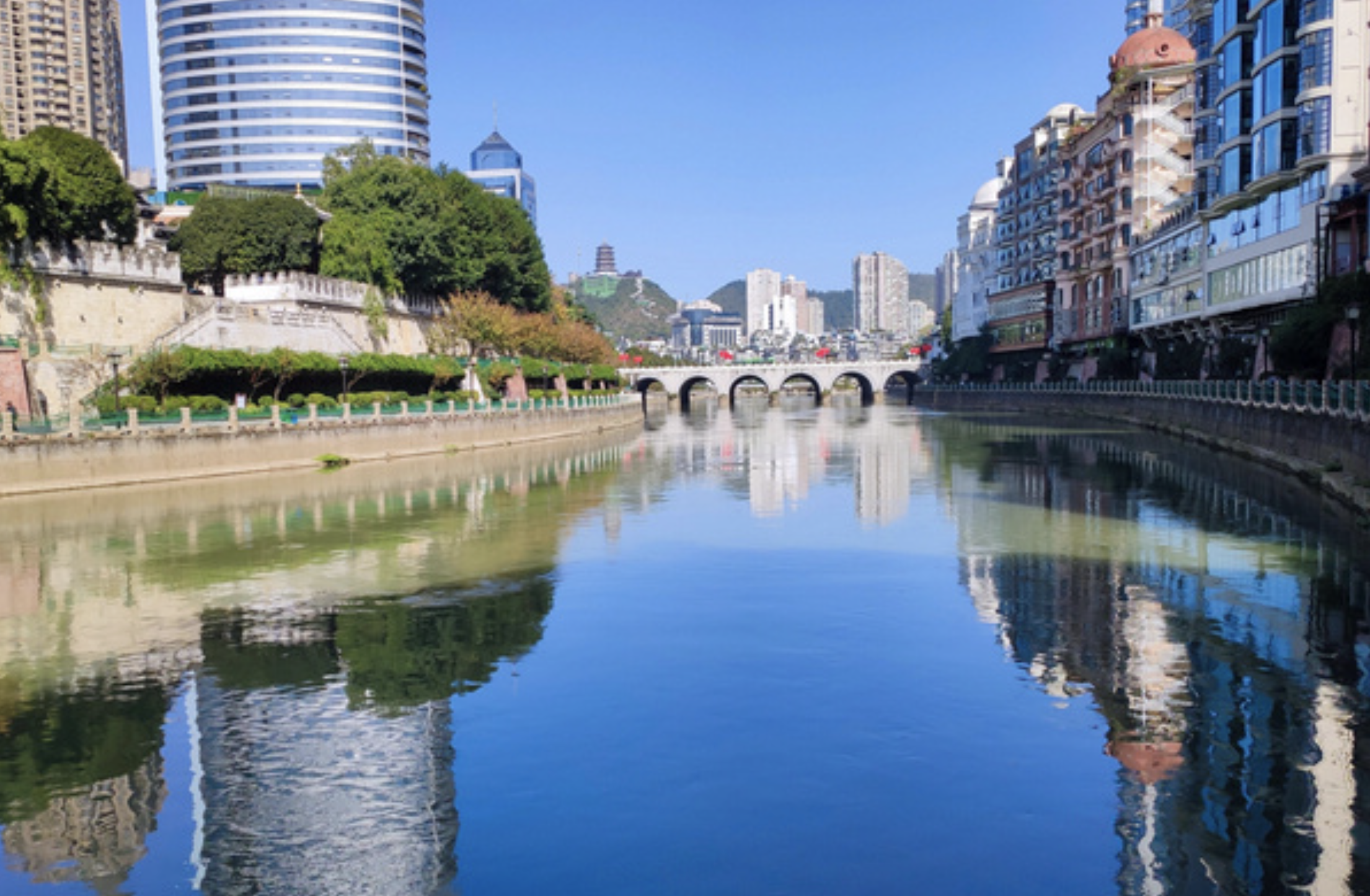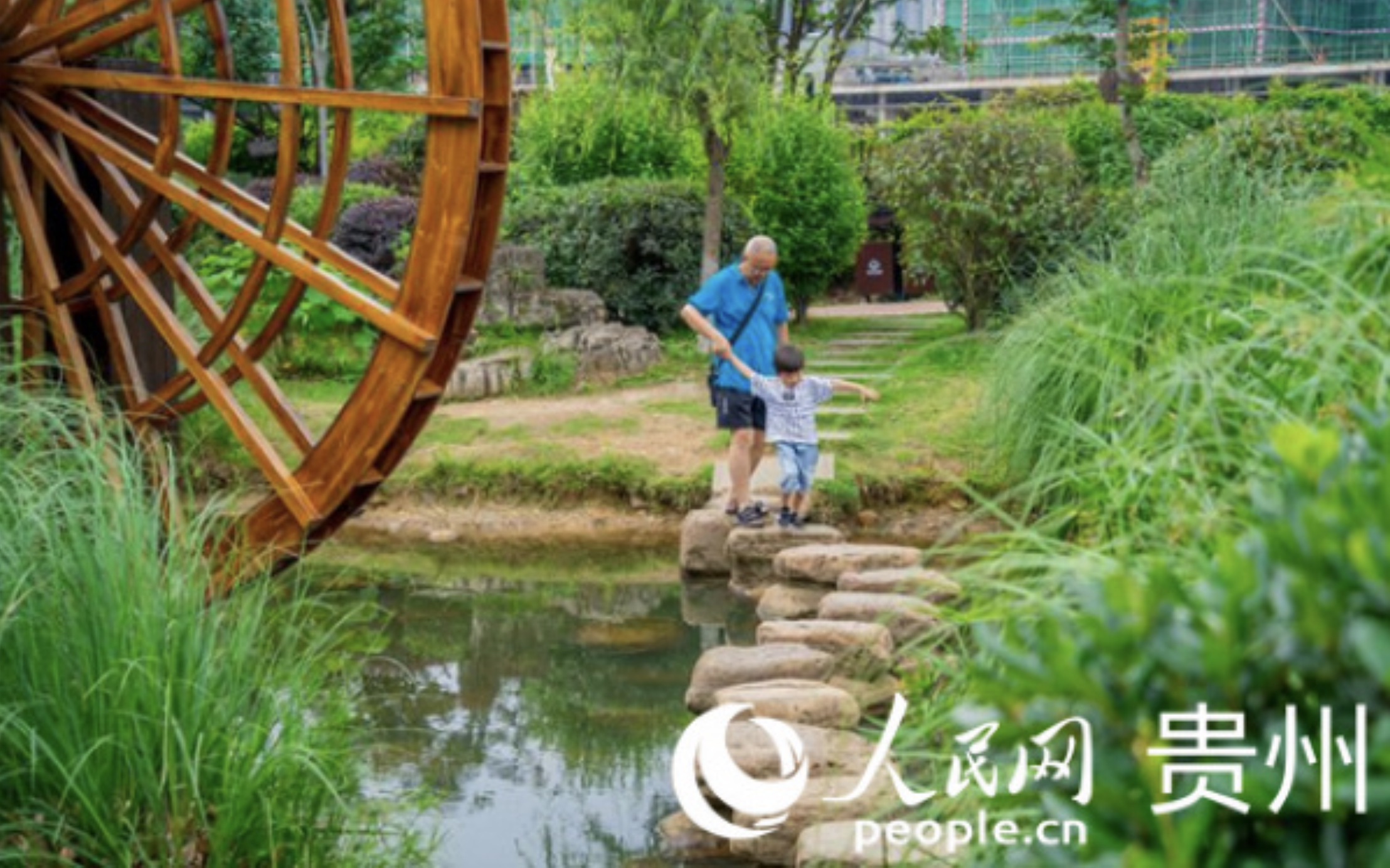People’s Daily Online|Restoring the Purity of the Nanming River
2021-07-11“People go home with poles on shoulders. They wash rice and vegetables along the river. There is enough grass on the banks to feed cattle and sheep. It is always a good time to stroll around the Nanming River.” This is the memory of Mr. Yang, who was flying a kite by the Nanming River, the mother river of Guiyang. “But it’s not always like this. Guiyang enters a period of rapid development. As people gather along the Nanming River, so do factories. Ten years ago, the Nanming River was nothing but a smelly river.” Mr. Yang looked at the egrets in the distance. “But it gets better now. You can even see egrets catching loaches in the river.”
Today, the Nanming River is about white egrets flying over the blue water and people watching the fish leisurely.
Treatment and prevention
From river treatment to long-term protection
The comprehensive treatment of the Nanming River could be traced back to 1956 when the first sewage pipeline was laid by the Guancheng River, a tributary of the Nanming River. The citizens of Guiyang have volunteered to dredge the Nanming River since the 1970s. The most impressive story is about the “river guard grandma” Lei Yueqin, who is over eighty years old. She impressed people as an old lady wearing a shirt, a sun hat and carrying a cane and water pot. Weak as she is, Lei Yueqin never gives up the hope for clean water and green mountains.
In September 2000, a stone tablet was established along the Nanming River, saying “restoring cleanness to the Nanming River in 3 years”. Guiyang has invested RMB 2.8 billion in 3 years, implementing 39 renovation projects in 10 categories. In 2004, the Nannming River becameclean, green and scenic again. The project won the National Award for Exemplary Human Habitation Environment jointly granted by 11 national ministries and commissions.
Beautiful scenery does not last long. Guiyang has embraced leapfrog economic and social development since 2004. By 2012, the regional GDP has soared more than four times and the population has increased from over 2 million to over 4 million. Sewage discharge has increased significantly, overloading the carrying capacity of the Nanming River. To meet the increasing water demand for production and urban life, Guiyang needs to provide moreecologic compensation water, which affects the river’s self-purification capacity. The pollution of the Nanming River has intensified and dredging efforts lessened. People complained the environmental impact frequently.

The Nanming River before treatment, October 24, 2013. By courtesy of CWEG

The Nanming River after treatment, October 23, 2020. By courtesy of CWEG
To thoroughly rectify the pollution of Nanming River, the city introduced a systematic treatment approach in 2012 which focused on both the trunk and tributary sections. Guiyangapproaches the treatment from the following aspects: source control and closure, internal section treatment, running water introduction, and ecological restoration. The comprehensive treatment plan is carried out in three stages: “intensive rectification, “root cause treatment”, and “system improvement”. The goal is to push the shift from a fragmented and temporary treatment model to a holistic and permanent solution by 2025.
14 of the 20 newly built sewage treatment plants in Guiyang have been located underground since 2017. As of the end of 2020, Guiyang has built 39 sewage treatment plants with a sewage treatment capacity of 2.058 million tons/day. The city has spent a total of RMB 7.591 billion since 2017 on the comprehensive treatment of the Nanming River. Totally 20 new reclaimed water plants have been built, including Wulichong, Xiaoguan, and Liuguangmen. Today, reclaimed water plants along the river have increased from 14 to 34 with sewage treatment capacity soaring from the previous 990,000 tons/day to 1.8358 million tons/day. The sewage treatment capacity of Guiyang has been greatly boosted.
Give a first try
From underground recycling to above ground landscaping
Guiyang, the hinterland of southwest China, has a population of nearly 5.987 million. The Nanming River, mother river of Guiyang, extends 219 kilometers with about 185 kilometers meandering through Guiyang. With increasing population and rapid urban development, the city craves more water. More domestic sewage means more treatment plants needed.

Qingshan Underground Wastewater Treatment Plant. By courtesy of Tu Min, People’s Daily Online
How to design a sewage treatment plant to maximize land use efficiency?
Qingshan Underground Wastewater Treatment Plant kicked off the construction inearly 2014. The plant was put into use at the end of 2014, and open to the public in 2015. Theunderground wastewater treatment plantturns out to be an entirely new solution to the question above.
On the ground is a beautiful park bustling with people and life while underground is a reclaimed water plant running in an orderly, safe and clean manner. TheQingshan Underground Wastewater Treatment Plantis located in the upper and middle reaches of the Nanming River, with a sewage treatment capacity of 50,000 tons per day and a service area of 11 square kilometers. The project costs RMB 350 million. The Guiyang Water Environment Science Museum and Ecological Park cover an area of about 128,292m2, tapping into the full usage of the land.
“Distributed underground reclaimed water plants have great advantages compared with traditional sewage treatment plants. Traditional sewage treatment plants are usually located in the lower reaches of cities. Sewage needs to be transported over a long distance before reaching the sewage treatment plants. There would be various environmental hazards in this process, such as sewage leakage due to pipeline damage. The treated water may flow elsewhere along the downstream river, which easily causes water scarcity upstream. According to Kong Hainan, Chair Professor, School of Environmental Science and Engineering, Shanghai Jiao Tong University, distributed reclaimed water plants can replenish the Nanming River with properly treated sewage in dry season.
After being processed at the sewage treatment plants, the qualified tailwater would be used to refill the Nanming River for ecological compensation purposes. The plants supply 1.5 million tons of ecological compensation water to the river every day.As a result, totally 500 million tons of diverted water could be saved every year.Meanwhile, the city scientifically manages the discharge flow of Huaxi Reservoir and Aha Lake Reservoir while ensuring water conservation. Other control measures include increasing the ecological flow of the river channel in a timely manner, scientifically opening and closing the flap dam along the Nanming River, and effectively improving the self-purification capacity of the river.
“Besides being used for ecological water replenishment, reclaimed sewage is also a useful resource. We are trying to apply the reclaimed water to more scenarios.” said Liu Chuxia, Deputy Director of the Guiyang Water Affairs Administration.
With the successful treatment of the Nanming River, Guiyang provides proven experience in the comprehensive treatment of rivers in the karst area and achieves a number of firsts in China. It is the first city in China to create and successfully implement the concept of segmented sewage treatment, the first city in China to build the underground sewage treatment ecosystem on a large scale, the first city in China to pilot the PPP model in water environment treatment and the first city in China to introduce “Three Changes” (resources into assets, funds into equity funds, and farmers into shareholders) into water environment treatment.
Currently, there are rich aquatic animals and plants in the Nanming River. The coverage rate of submerged plants has increased from 15% to 75%. Birds such as Chinese Merganser, which are sensitive to water quality, are hunting here. Biodiversity, the coverage of aquatic plants, and the ecosystem integrity have been greatly improved.The Nanming River has been restored to a beautiful landscape where nature and people live in harmony.
“We have not only built distributed underground reclaimed water plants along the Nanming River, but also carried out ecological restoration and landscaping for 120 kilometers”. CWEG President Hou Feng said that most urban rivers only attain the standard of Class IV. While Guiyang is building an ecological Nanming River and developing river landscapes and river culture to boost biodiversity. Such treatment measures are a big step forward.
Peace and harmony
From pollution control to the harmony of people and nature
In the 1990s, there were more than 200 industrial companies and nearly 100 domestic sewage outlets on both sides of the Nanming River. 450,000 tons of domestic sewage and industrial wastewater was dumped into the river every day, becoming the “culprit” of the pollution. Since the 18th National Congress of the Communist Party of China, Guiyang has been advancing the supply-side structural reform. The local government has implemented the policy of “industries withdrawing from the city and entering the park”. Industrial enterprises such asGuiyang Steel Mill, Guiyang Aluminum Mill, and cement plantsare required to move into the industrial park and stop discharging pollutants into rivers. There is no more industrial sewage discharge along the entire Nanming River.

Landscape of the Nanming River. By courtesy of Tang Jie, People’s Daily Online
In order to improve the river quality, Guiyang has been carrying out fishery proliferation and release for 15 consecutive years since 2006. A total of more than 300 million fish fry have been released into the river. Significant ecological, economic and social benefits have been achieved along the Wu River and Nanming River, laying a solid foundation for the restoration of fish and other aquatic wildlife. In mid-June this year, Guiyang released 1,177,500 seedlings (grass carp, herring, silver carp, silver carp) sized 10-20 cm in the Nanming River.
“People think differently now. They obey higher moral standard and do notthrow rubbish into rivers”, said Liu Banggui, who has worked in the Maintenance and Construction Office of the Guiyang River Management Bureau for 35 years. “There is little garbage around. We wear water-proof pants to do cleaning. In the past, we used boat to collect rubbish.”
Currently, 25 black and odorous water sections along the Nanming River have been rectified. The water quality of 7 major tributaries have reached the normal standard. The water quality of the downtown sections has reached Class IV, and some sections have reached even Class III and above.The river's self-purification capacity has beenstrengthened. The city has attained control goals such as “deodorization”, “water purification” and “scenic view”.
“Fish, shrimp, and egrets”, “people, scenery, and culture”. River treatment and protection must be carried out regularly. Guiyang will continue on the path towards green mountains and clean waters. Green ecology, green culture, green urban and rural areas, and green scenic spots have become the highlights of a colorful Guizhou. Green mountains, clean waters, lush forests, and people are co-existing in harmony. (By Tang Jie, Intern)
link:http://gz.people.com.cn/n2/2021/0711/c222152-34814740.html
 中国水环境集团
中国水环境集团









